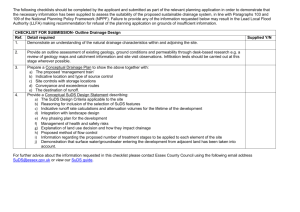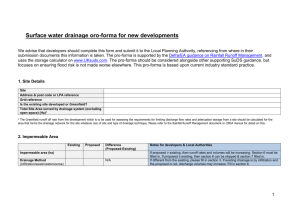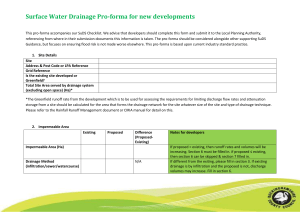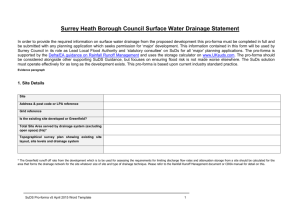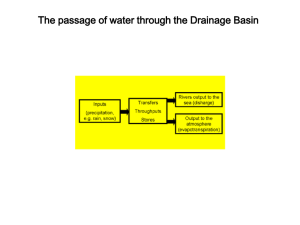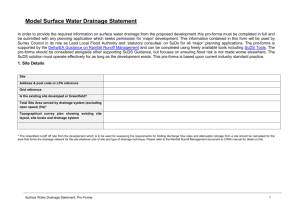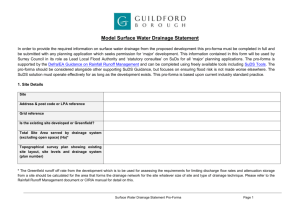Advice Note on the required contents of a Sustainable Drainage
advertisement
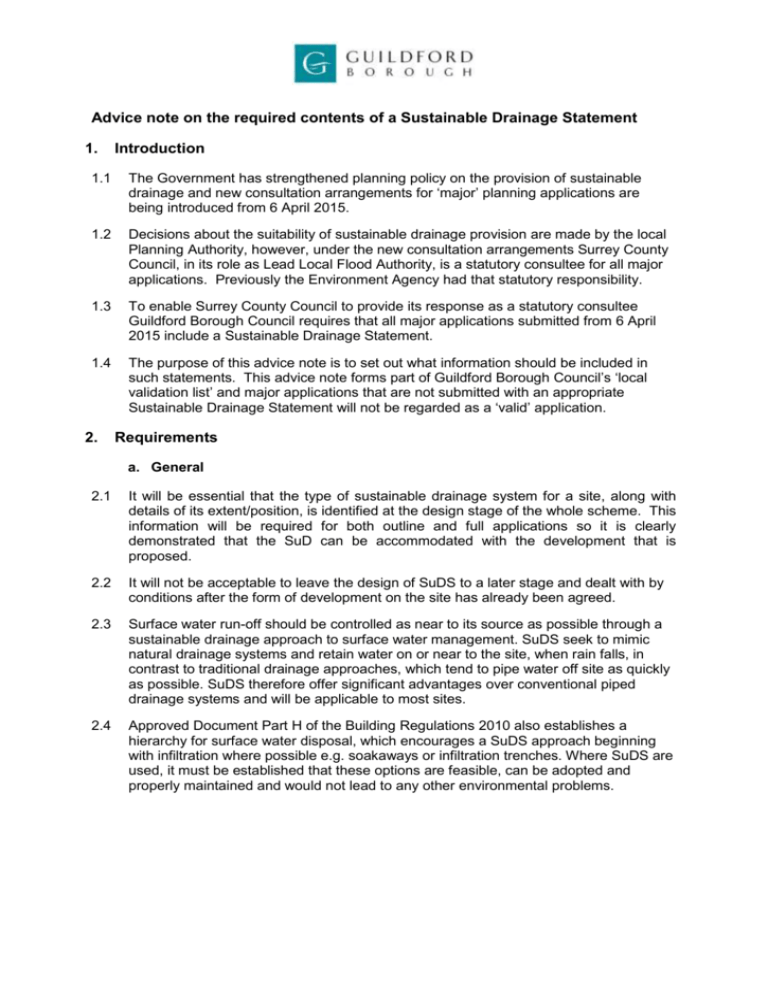
Advice note on the required contents of a Sustainable Drainage Statement 1. Introduction 1.1 The Government has strengthened planning policy on the provision of sustainable drainage and new consultation arrangements for ‘major’ planning applications are being introduced from 6 April 2015. 1.2 Decisions about the suitability of sustainable drainage provision are made by the local Planning Authority, however, under the new consultation arrangements Surrey County Council, in its role as Lead Local Flood Authority, is a statutory consultee for all major applications. Previously the Environment Agency had that statutory responsibility. 1.3 To enable Surrey County Council to provide its response as a statutory consultee Guildford Borough Council requires that all major applications submitted from 6 April 2015 include a Sustainable Drainage Statement. 1.4 The purpose of this advice note is to set out what information should be included in such statements. This advice note forms part of Guildford Borough Council’s ‘local validation list’ and major applications that are not submitted with an appropriate Sustainable Drainage Statement will not be regarded as a ‘valid’ application. 2. Requirements a. General 2.1 It will be essential that the type of sustainable drainage system for a site, along with details of its extent/position, is identified at the design stage of the whole scheme. This information will be required for both outline and full applications so it is clearly demonstrated that the SuD can be accommodated with the development that is proposed. 2.2 It will not be acceptable to leave the design of SuDS to a later stage and dealt with by conditions after the form of development on the site has already been agreed. 2.3 Surface water run-off should be controlled as near to its source as possible through a sustainable drainage approach to surface water management. SuDS seek to mimic natural drainage systems and retain water on or near to the site, when rain falls, in contrast to traditional drainage approaches, which tend to pipe water off site as quickly as possible. SuDS therefore offer significant advantages over conventional piped drainage systems and will be applicable to most sites. 2.4 Approved Document Part H of the Building Regulations 2010 also establishes a hierarchy for surface water disposal, which encourages a SuDS approach beginning with infiltration where possible e.g. soakaways or infiltration trenches. Where SuDS are used, it must be established that these options are feasible, can be adopted and properly maintained and would not lead to any other environmental problems. 2.5 Where the intention is to dispose to soakaway, these should be shown to work through an appropriate assessment carried out under Building Research Establishment Digest 365. 2.6 Before disposal of surface water to the public sewer is considered all other options set out in Approved Document Part H of the Building Regulations 2010 should be exhausted. When no other practicable alternative exists to dispose of surface water other than the public sewer, the Water Company or its agents should confirm that there is adequate spare capacity in the existing system taking future development requirements into account. 2.7 Where an application is part of a larger site which already has planning permission it is essential that the new proposal does not compromise the drainage scheme already approved. 2.8 Development which involves a culvert or an obstruction to flow on an Ordinary Watercourse will require consent under the Land Drainage Act 1991 and the Floods and Water Management Act 2010. In the case of an Ordinary Watercourse the responsibility for Consenting lies with the Lead Local Flood Authority (LLFA). An Ordinary Watercourse is defined as any watercourse not identified as a Main River on maps held by the Environment Agency and DEFRA. For further information on Ordinary Watercourses contact the LLFA. We would still wish to be consulted on any proposed culverting or an obstruction to flow on a Main River b. Content of the Sustainable Drainage Statement 2.9 The Statement will draw on other information contained with the Planning Application and in particular any Flood risk Assessment and must provide a clear explanation of the SuD proposed and the reasons why it is the most suitable for the site. 2.10 As a minimum the following information must be provided in the statement: Site location plan. Topographical survey information of the site to show existing site levels. Details of the site’s geology/drift material overlaying it. Details of any contamination on the site and how this has been taken into account in the SuD design Proposed type of development and layout. Demonstration that the proposed form of sustainable drainage proposed has had regard to the SuD hierarchy. Layout showing where the sustainable drainage infrastructure will be located on the site (e.g. location of water storage). Details of any proposed drainage off the site (e.g. groundwater movement, ditches, pipes, etc) and where it will drain to. Micro-drainage calculations of existing and proposed run-off rates and volumes unless full infiltration test in accordance with BRE 365 are submitted. Back-up attenuation scheme if on-site infiltration is proposed. Details of the management and maintenance of the SUD so it continues to meet the requirements (currently in the draft National Standards) for the lifetime of the development. Details of how the management and maintenance will be secured for the lifetime of the development. 2.11 In all cases the pro-forma at Appendix A to this Advice Note must be submitted. 3. Further information and guidance 3.1 Applicants are strongly advised to discuss their proposals with Surrey County Council at the pre-application stage to ensure that an acceptable SuDS scheme is submitted. You should contact Surrey County Council directly for details of their pre-application process. 3.2 For general clarification of these requirements please contact Guildford Borough Council. Appendix A Pro-forma to accompany Sustainable Drainage Statements This pro-forma accompanies (xxx Council’s) Advice Note on the required contents of a Sustainable Drainage Statement. It must be completed in full and attached to that Statement and will form part of the essential information required by Surrey Council in its role as Lead Local Flood Authority and ‘statutory consultee’ on SuDs for all ‘major’ planning applications. The pro-forma is supported by the Defra/EA guidance on Rainfall Runoff Management. and uses the storage calculator on www.UKsuds.com. The pro-forma should be considered alongside other supporting SuDS Guidance, but focuses on ensuring flood risk is not made worse elsewhere. This pro-forma is based upon current industry standard practice. 1. Site Details Site Address & post code or LPA reference Grid reference Is the existing site developed or Greenfield? Total Site Area served by drainage system (excluding open space) (Ha)* * The Greenfield runoff off rate from the development which is to be used for assessing the requirements for limiting discharge flow rates and attenuation storage from a site should be calculated for the area that forms the drainage network for the site whatever size of site and type of drainage technique. Please refer to the Rainfall Runoff Management document or CIRIA manual for detail on this. 2. Impermeable Area Existing Proposed Difference Notes for developers & Local Authorities (Proposed-Existing) Impermeable area (ha) If the proposed amount of impermeable surface is greater, then runoff rates and volumes will increase. Section 6 must be filled in. If proposed impermeability is equal or less than existing, then section 6 can be skipped & section 7 filled in. (areas to be shown on a plan) Drainage Method (infiltration/sewer/watercourse) N/A If different from the existing, please fill in section 3. If existing drainage is by infiltration and the proposed is not, discharge volumes may increase. Fill in section 6. 3. Proposing to Discharge Surface Water via Yes No Evidence that this is possible Notes for developers & Local Authorities Infiltration e.g. soakage tests. Section 6 (infiltration) must be filled in if infiltration is proposed. To watercourse e.g. Is there a watercourse nearby? To surface water sewer The Confirmation from sewer provider that sufficient capacity exists for this connection. Combination of above e.g. part infiltration part discharge to sewer or watercourse. Provide evidence above. 4. Peak Discharge Rates – This is the maximum flow rate at which storm water runoff leaves the site during a particular storm event. Existing Rates (l/s) Greenfield QBAR 1 in 1 1 in 30 1in 100 Proposed Rates (l/s) Difference (l/s) N/A N/A Notes for developers & Local Authorities (Proposed-Existing) QBAR is approx. 1 in 2 storm event. Provide this if Section 6 (QBAR) is proposed. Proposed discharge rates (with mitigation) should be no greater than existing rates for all corresponding storm events. e.g. discharging all flow from site at the existing 1 in 100 event increases flood risk during smaller events. 1 in 100 plus climate change N/A To mitigate for climate change the proposed 1 in 100 +CC must be no greater than the existing 1 in 100 runoff rate. If not, flood risk increases under climate change. 30% should be added to the peak rainfall intensity. 5. Calculate additional volumes for storage –The total volume of water leaving the development site. New hard surfaces potentially restrict the amount of stormwater that can go to the ground, so this needs to be controlled so not to make flood risk worse to properties downstream. Existing Volume (m3) Proposed Volume (m3) Difference (m3) Notes for developers & Local Authorities (Proposed-Existing) 1 in 1 1 in 30 Proposed discharge volumes (without mitigation) should be no greater than existing volumes for all corresponding storm events. Any increase in volume increases flood risk elsewhere. Where volumes are increased section 6 must be filled in. 1in 100 1 in 100 plus climate change To mitigate for climate change the volume discharge from site must be no greater than the existing 1 in 100 storm event. If not, flood risk increases under climate change. 6. Calculate attenuation storage – Attenuation storage is provided to enable the rate of runoff from the site into the receiving watercourse to be limited to an acceptable rate to protect against erosion and flooding downstream. The attenuation storage volume is a function of the degree of development relative to the greenfield discharge rate. Notes for developers & Local Authorities Storage Attenuation volume (Flow rate control) required to retain rates as existing (m3) Volume of water to attenuate on site if discharging at existing rates. Can’t be used where discharge volumes are increasing 7. How is Storm Water stored on site? Storage is required for the additional volume from site but also for holding back water to slow down the rate from the site. This is known as attenuation storage and long term storage. The idea is that the additional volume does not get into the watercourses, or if it does it is at an exceptionally low rate. You can either infiltrate the stored water back to ground, or if this isn’t possible hold it back with on-site storage. Firstly, can infiltration work on site? Notes for developers & Local Authorities Infiltration In light of the above , is infiltration feasible? State the Site’s Geology and known Source Protection Zones (SPZ) Avoid infiltrating in made ground. Infiltration rates are highly variable and refer to Environment Agency website to identify and source protection zones (SPZ) Are infiltration rates suitable? Infiltration rates should be no lower than 1x10 State the distance between a proposed infiltration device base and the ground water (GW) level Need 1m (min) between the base of the infiltration device & the water table to protect Groundwater quality & ensure GW doesn’t enter infiltration devices. Avoid infiltration where this isn’t possible. Were infiltration rates obtained by desk study or infiltration test? Infiltration rates can be estimated from desk studies at most stages of the planning system if a back up attenuation scheme is provided.. Is the site contaminated? If yes, consider advice from others on whether infiltration can happen. Water should not be infiltrated through land that is contaminated. The Environment Agency may provide bespoke advice in planning consultations for contaminated sites that should be considered. Yes/No? If the answer is No, please identify how the storm water will be stored prior to release -6 m/s. If infiltration is not feasible how will the additional volume be stored?. The applicant should then consider the following options in the next section. Storage requirements The developer must confirm that either of the two methods for dealing with the amount of water that needs to be stored on site. Option 1 Simple – Store both the additional volume and attenuation volume in order to make a final discharge from site at QBAR (Mean annual flow rate). This is preferred if no infiltration can be made on site. This very simply satisfies the runoff rates and volume criteria. Option 2 Complex – If some of the additional volume of water can be infiltrated back into the ground, the remainder can be discharged at a very low rate of 2 l/sec/hectare. A combined storage calculation using the partial permissible rate of 2 l/sec/hectare and the attenuation rate used to slow the runoff from site. Notes for developers & Local Authorities Please confirm what option has been chosen and how much storage is required on site. The developer at this stage should have an idea of the site characteristics and be able to explain what the storage requirements are on site and how it will be achieved. 8. Please confirm Notes for developers & Local Authorities Which Drainage Systems measures have been used? SUDS can be adapted for most situations even where infiltration isn’t feasible e.g. impermeable liners beneath some SUDS devices allows treatment but not infiltration. See CIRIA SUDS Manual C697. Drainage system can contain in the 1 in 30 storm event without flooding This a requirement for sewers for adoption & is good practice even where drainage system is not adopted. Any flooding between the 1 in 30 & 1 in 100 plus climate change storm events will be safely contained on site. Safely: not causing property flooding or posing a hazard to site users i.e. no deeper than 300mm on roads/footpaths. Flood waters must drain away at section 6 rates. Existing rates can be used where runoff volumes are not increased. How are rates being restricted (hydrobrake etc) Hydrobrakes to be used where rates are between 2l/s to 5l/s. Orifices not be used below 5l/s as the pipes may block. Pipes with flows < 2l/s are prone to blockage. Please confirm the owners/adopters of the entire drainage systems throughout the development. Please list all the owners. If these are multiple owners then a drawing illustrating exactly what features will be within each owner’s remit must be submitted with this Proforma. How is the entire drainage system to be maintained? If the features are to be maintained directly by the owners as stated in answer to the above question please answer yes to this question and submit the relevant maintenance schedule for each feature. If it is to be maintained by others than above please give details of each feature and the maintenance schedule. Clear details of the maintenance proposals of all element of the proposed drainage system must be provided. Poorly maintained drainage can lead to increased flooding problems in the future. 10. Evidence Please identify where the details quoted in the sections above were taken from. i.e. Plans, reports etc. Please also provide relevant drawings that need to accompany your proforma, in particular exceedence routes and ownership and location of SuDS (maintenance access strips etc Pro-forma Section Section 2 Section 3 Section 4 Section 5 Section 6 Section 7 Document reference where details quoted above are taken from Page Number The above form should be completed using evidence from the Flood Risk Assessment and site plans. It should serve as a summary sheet of the drainage proposals and should clearly show that the proposed rate and volume as a result of development will not be increasing. If there is an increase in rate or volume, the rate or volume section should be completed to set out how the additional rate/volume is being dealt with. This form is completed using factual information from the Flood Risk Assessment and Site Plans and can be used as a summary of the surface water drainage strategy on this site. Form Completed By……………………………………………………………………………………....................... Qualification of person responsible for signing off this pro-forma ........................................................... Company……………………………………………………………………………,.................................................. On behalf of (Client’s details) ......................................................................................................................... Date:……………………………............................

